It would be impossible to imagine today’s music scene without the electric guitar. This iconic instrument single-handedly revolutionized the world of music with its millions of sonic possibilities and has birthed a mind-boggling variety of genres – from rock, blues, jazz, metal, rock n ‘ roll, and many more. So if you want to learn more about it, we will be covering all the parts of an electric guitar in-depth below.
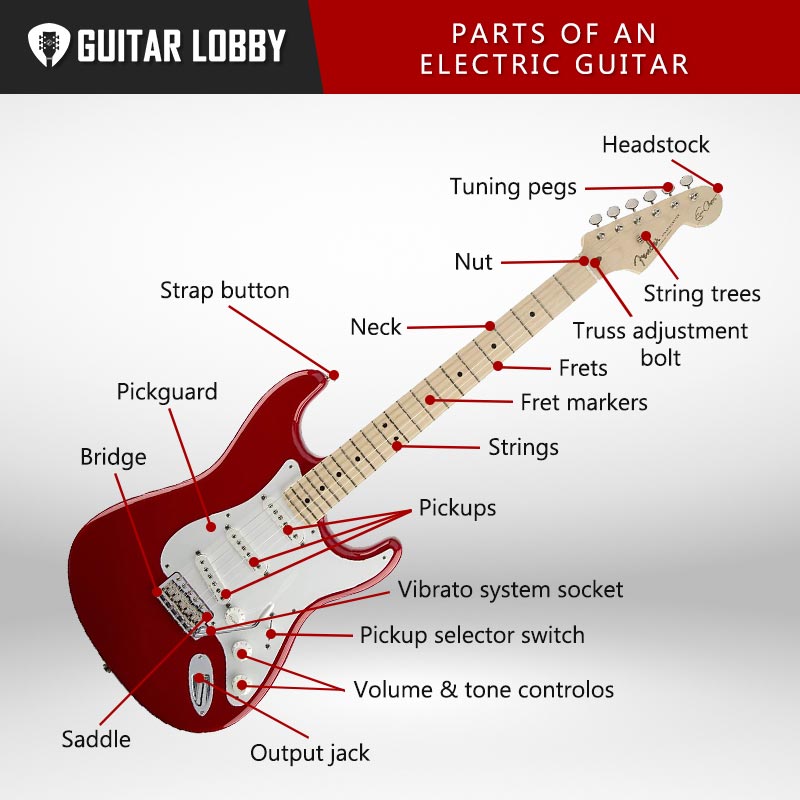
This article will cover each part of the guitar in detail and we’ve included diagrams and videos to help you better understand the instrument.
Table of Contents
Anatomy of an Electric Guitar Explained
The electric guitar is made up of several different parts, which can be grouped under a few different sections. The entire electric guitar can be divided into the following sections: the headstock, body, neck, strings, hardware, and onboard electronics. We’ll cover each part below, but if you’d like you can also check out this video by Fender that explains each part.
Headstock
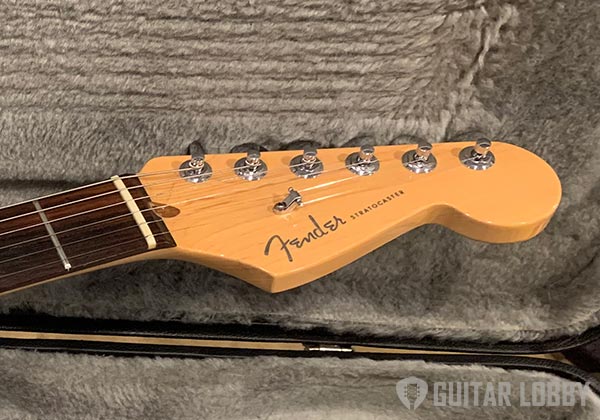
Mounted on top of the neck, at the very beginning of the instrument is a flat piece of wood that flashes the brand logo of the guitar. The headstock packs in many essential parts of the instrument such as the tuners, nut, and string retainers (read about them in the hardware section). This is the place where you tune the strings using the machine heads and which holds the strings in place once you are done tuning them. The most common type of headstock you’ll find on an electric guitar is either a flat shaped and angled or tilted headstock.
Body
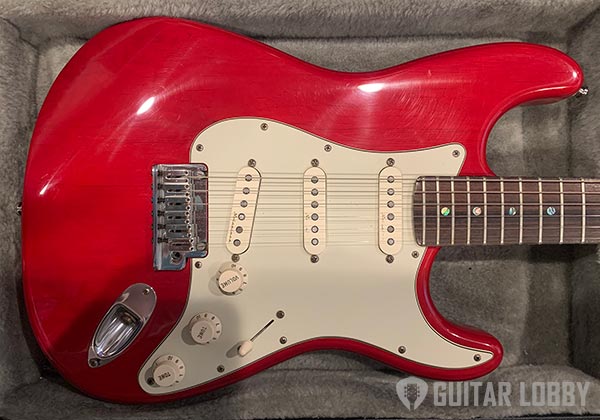
The body is perhaps the first thing one looks at before buying an electric guitar. Is it a solid body, hollow or semi-hollow? A stratocaster, telecaster, Les Paul or SG? What is the neck profile, and how is it attached to the body? Simply put, the body and neck of an electric guitar have a lot riding on it particularly the way it affects the tone, visual appeal, and feel. So, let’s dive in and get familiar with the largest parts of an electric guitar.
The body of an electric guitar anchors the neck and is home to the bridge assembly and all the electronics parts including pickups and control. While most acoustics have hollow bodies with a soundhole, electric guitars are crafted in solid, semi-hollow, and hollow types.
Solid-body electrics, as the name suggests, are made from solid wood and don’t have a resonating soundboard to amplify string vibrations. They have excellent sustain and resistance to feedback compared to the other two body types. All four iconic electric shapes- Fender Stratocaster and Telecaster and Gibson’s Les Paul and SG are solid-body instruments.
Semi-hollows are also known as semi-acoustics and offer players the best of both worlds– acoustic and electric experience. These guitars have a solid tone block that runs down the length of the body. They are incredibly versatile and work well with any genre be it blues, folk, jazz, country, or even rock.
A totally hollow electric does not have the tone block like a semi-hollow. They are known for producing highly resonant, bright warm tones making it ideal to play jazz in an intimate gig setting.
Pickguard
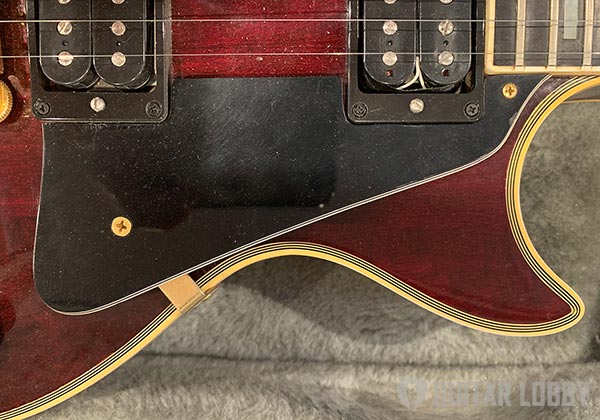
To keep your prized possession from having scratch marks all over it, you need a pickguard! This layer shields the body from getting scratched by pick strokes. But that’s not the only thing it does. In models like Fender Stratocaster, onboard electronics come mounted on this plastic layer. Pickguards are available in many variants including white, pearly, black, or tortoiseshell pattern.
Output Jack
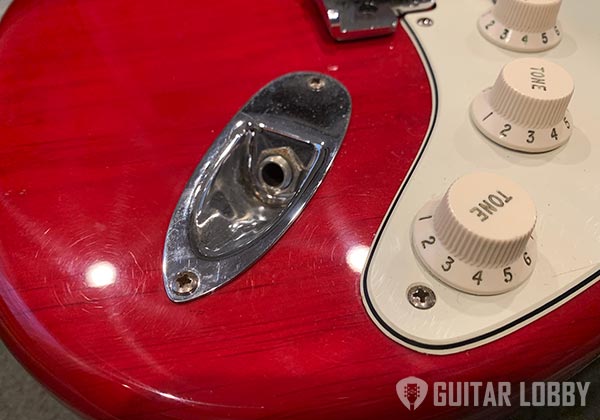
The jack socket is where you plug the cable. Signals from the electric components travel here and reach the amplifier once you connect the two via a chord. This little part is the connecting bridge between your instrument and the amplifier, so it’s a pretty crucial component. At the same time, it can also be subject to a lot of wear and tear if you’re rough while plugging and unplugging your cable – which can damage your guitar! To avoid this, don’t be in a hurry and always plug and unplug your cable gently.
Pro tip: Another common slip-up that guitarists do is that they don’t secure their cable around the guitar strap, and plug the cable directly onto the jack – this puts you at the risk of stepping over your cable and unplugging it if you’re not careful! So when plugging in the cable, make sure that you bring it around from inside the bottom portion of your guitar strap before plugging it in.
Neck
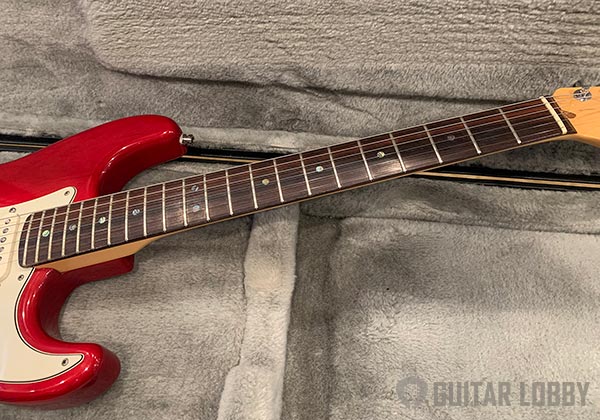
As the part that a player most engages with, neck matters! It’s the long piece of wood connected to the body that houses the fretboard, frets, nut, tuners, and truss rod. The tonewood used in the neck is an important factor while choosing an electric. Most electric guitar necks are made of Maple. It is hard, strong, and stable with a bright tone.
A neck is usually found set-in or bolt-on to the body. Though, in solid body electrics, necks extend through the length of the guitar.
Set (or glued-in) necks, found on Gibson Les Paul, are methodically cut, matched and mounted on the body with dove-tail joints for stability. These fare well in providing sustain.
Made famous by Leo Fender, bolt-on necks are attached to the body by wooden screws or bolts. You’ll find them on many solid-body electrics including Fender Stratocasters.
While the tonewood used in crafting the neck contributes to the sonic element, it’s the shape that determines the instrument’s playability. The necks, designed in “C”, “U”, and “V” and their widths affect a player’s comfort and how the instrument feels to play.
Truss Adjustment Bolt
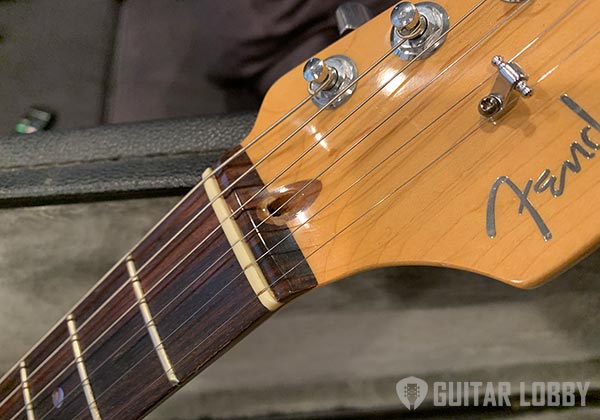
The truss adjustment bolt sits on the headstock and is used to adjust the curve of the neck. Turning the bolt clockwise tightens it, which straightens the neck or creates a slightly backward bow. On the other hand, turning it anti-clockwise loosens the bolt, which can create a forward bow for a higher string action.
Truss Rod
A truss road is a metal bar, typically made up of steel or similar corrosion-resistant stuff. You’ll find it sitting snugly inside the neck to stop it from bending under the pressure from tuned-up strings. A well-adjusted truss rod is crucial in stabilizing the curvature of the neck and in keeping fret buzz and intonation problems at bay. There are two types of truss rods- single-action that can adjust the neck in one direction or double action that can do the job in either direction.
Fretboard
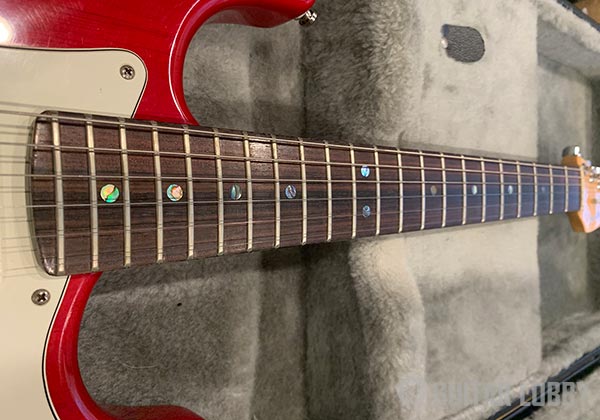
This is where you place your dominant hand to make music! Also known as the fingerboard, this wooden part is placed on top of the neck, underneath the strings, and holds all the metal frets. The wood used to make the fingerboard is sometimes different from the neck. The most common fretboard woods are maple, rosewood, and ebony.
Frets & Fret Markers

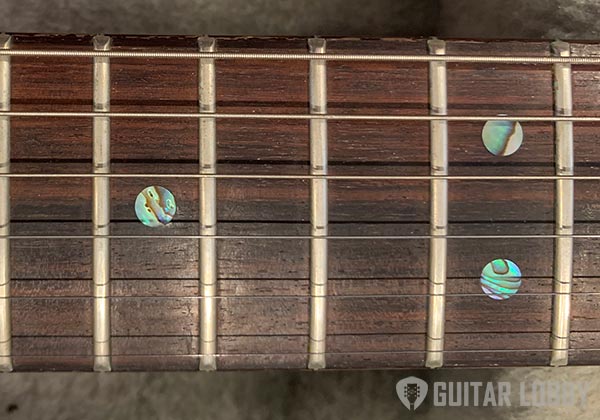
Most electric guitars come with either 21, 22, or 24 frets. These are thin, raised metal strips embedded in the fretboard. They are laid out evenly across the fretboard, with the spacing determined by how long or short the neck is.
The size and thickness of fret wire is not something we usually pay attention to, but believe it or not, it affects the tone and playability of the instrument. The high and wide work brilliantly for producing solo while wide and low ones facilitate breezy navigation of the fretboard.
Inlay markers are basically just dots or marks that tell you where you are on the fretboard. They make fretboard navigation easier for beginners.
Strings
Literally “the heart” of a guitar! There’s no music without these sonic beauties! Most electric guitars have six strings, though there are other variants that are 7-string, 8 string (usually used for playing metal), and some that are even 12 strings and up!
Guitar strings come in different thicknesses (gauge) and metal. While strings with heavier gauges offer more durability, sustain, and volume, lighter gauges produce more treble and are easier to play.
Like gauge, the metal used in making the strings influence the sound of the instrument, Nickel-plated steel, pure nickel, or stainless steel are the three most popular construction materials for electric strings, each known for producing a distinctive sound.
Nickel-Plated Steel: Most electric guitarists use these. Nickel wound strings are known for producing a balanced, mid-range, warm tone. They also offer sharper attack than pure nickel strings.
Pure Nickel: Made with pure nickel wrap wire on a round core wire, these strings are not as easily found as nickel-plated ones. They produce a warmer, vintage tone with less mid-range compared to nickel-plated strings.
Stainless Steel: Brighter and snappier of all electric guitar strings, stainless steel strings are a good bet if durability is what you seek.
We already know that guitar strings are constructed by wrapping some sort of material around a central core wire. But did you know the fashion in which a string is wound also affects the sound?
Roundwound is the most popular way for string winding. These strings are wound up round, have ridged texture, and offer more attack and better sustain. In, flatwound strings, wrapping material is compressed and wound around and inner core wire, leaving far fewer ridges behind. It is smooth, with a darker tone. Perfect for jazz and blues players! Overall, strings are easily one of the most important parts of an electric guitar.
Hardware
If the body, neck, and strings create the sound profile, your guitar’s hardware and metal bits are what keep that fantastic tone in check!
Tuning Pegs
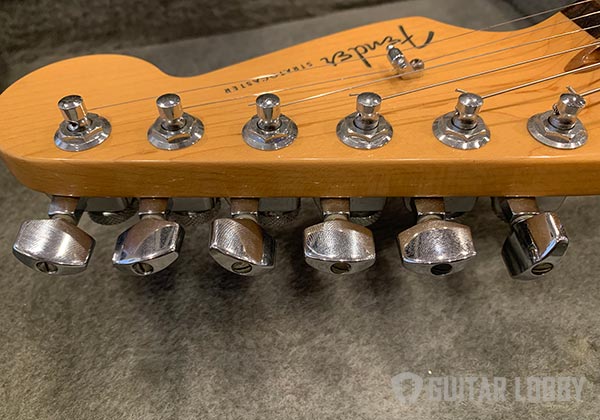
The name says it all! These metal knobs tune and hold the pitch. They are found on the headstock with strings wound around them. To tweak the pitch of a string, all you need to do is twist these knobs to raise or lower the tension in the strings. Good quality guitar tuners come with corrosion-resistant plating making them highly durable compared to the inexpensive ones.
Bridge and Saddle
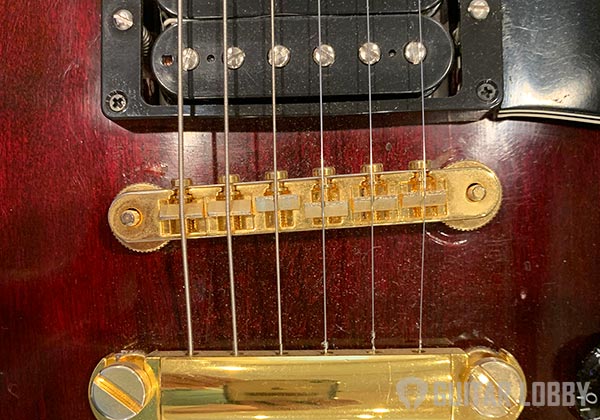
An electric guitar’s bridge wears many hats. Besides anchoring the strings to the body, the bridge also sets the tone and adjusts the playing action.
Bridges are either fixed or floating. Hardtail bridges are said to provide enhanced attack, sustain, and stable tuning. Floating or tremolo bridges, on the other hand, facilitate vibratos and let you bend all strings at once but are harder to tune.
By adjusting the height of the lower part of the bridge, known as the saddle, you can alter the distance between the strings and the fretboard to get better action.
Let’s talk about saddles in more detail here. They mark the end of the playable length of the strings. Most electric guitars, unlike single-saddled acoustics, tend to have individual saddles per string for greater control over intonation. Although, some, like the famous Telecaster, have a 3-saddle setup.
Nut
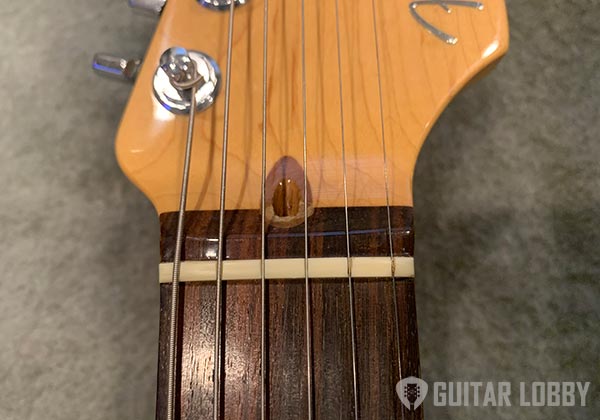
If you don’t look closely, you might not even notice it. This small wonder is the secret to getting the best out of your guitar! Commonly made up of bone, plastic, or metal, the nut is one of the two endpoints of the vibrating string, the other being the bridge saddle.
Each nut has a slot that holds the string in place. A well-shaped, fitted nut with the right-sized slot makes sure the tone and tuning don’t stray, and the strings sit at the proper height to avoid any fret buzz.
String Trees
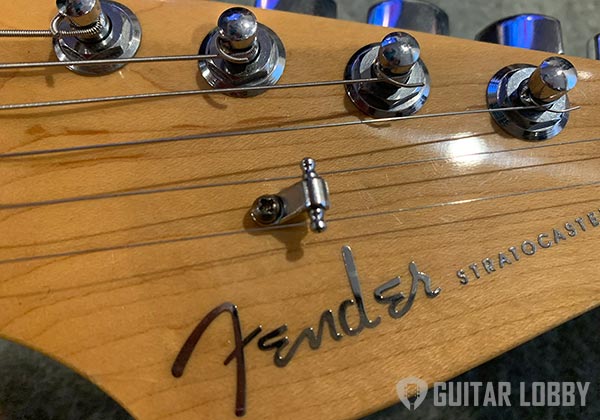
You won’t find them on all guitars, but these little metal widgets have a pretty important job on their shoulders!
String trees, also known as string retainers, exert downward tension at the point where strings break over the nut. Raising the break angle ensures strings stay in place and don’t pop out of the nut slots during playing. This enhanced pressure leads to more sustain when strings are played open.
Guitars that don’t have string trees usually have headstocks tilted backward from the neck. This feature creates the right break angle to keep the strings well-slotted. Popular electric models like Fender Strats and Telecasters rely on string trees for improved string tension and better sustain.
Tailpiece
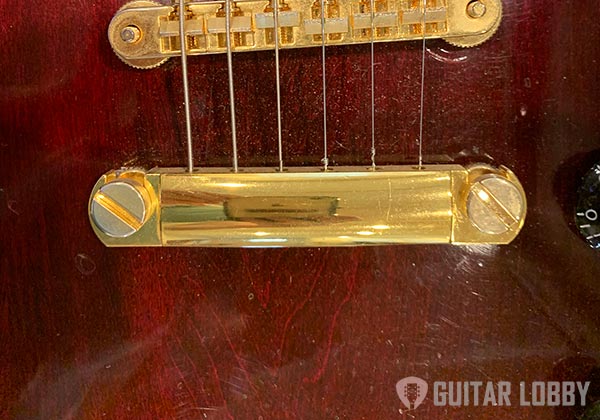
Bridges like Tune-o-Matic come with a separate stop bar or tailpiece. Like string trees, the guitar tailpiece is not a part of every guitar but only those that have floating bridges, since such bridges only guide but don’t hold the strings. A tailpiece is a metal part that’s fixed at the end of the guitar with screws. It works by gripping the strings and securing them to the bridge.
Strap Buttons
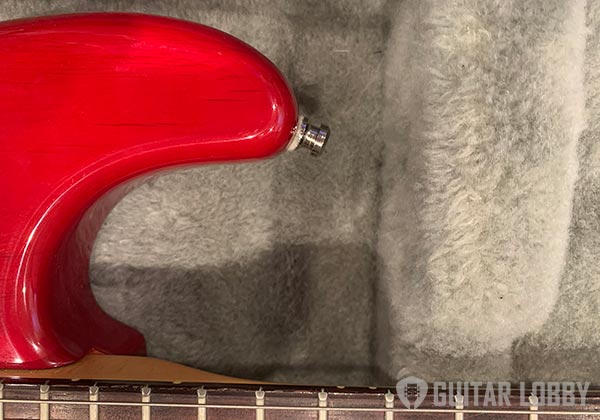
This is where you attach your guitar strap to secure it. There are two strap buttons screwed into the body to accommodate the strap ends. Keeping one button fastened on the tail end, you can relocate the other button from its place at the neck end for enhanced comfort and stability. Popular spots are- on the back near the heel cap, on the heel cap, and the side close to the neck heel.
Vibrato System
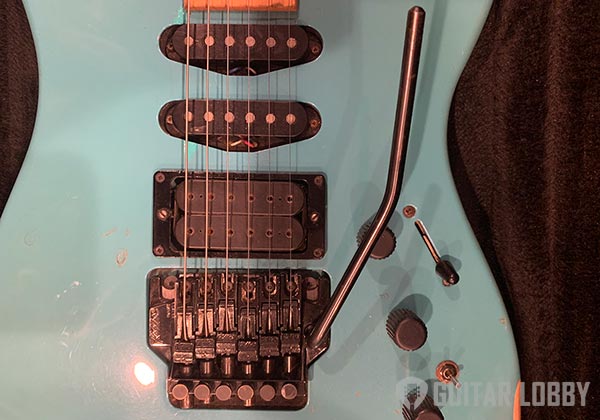
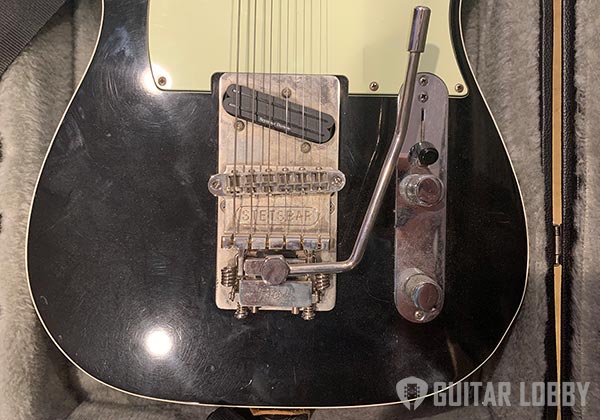
Vibrato bar, whammy bar, tremolo arm, Bigsby arm, this fascinating apparatus has many names but one purpose- to provide a rapid modulation in the pitch by tweaking the string tension at one go. They are usually installed at the bridge or tailpiece of an electric guitar.
Guitar legends like Jimi Hendrix, Eddie Van Halen, Steve Vai have all made generous and extremely creative use of the whammy bar. If rock or metal are where your interests lie, you simply cannot do without owning one!
Onboard Electronics
Make way for the sound shapers- the electronics that are built into your electric guitar. The importance of robust, reliable, high-quality onboard electronics cannot be stressed enough! Think of all the amazing sounds and tones you can create with the right set of onboard specs. Let’s read about these super essential parts of an electric that set it apart from an acoustic.
Pickups
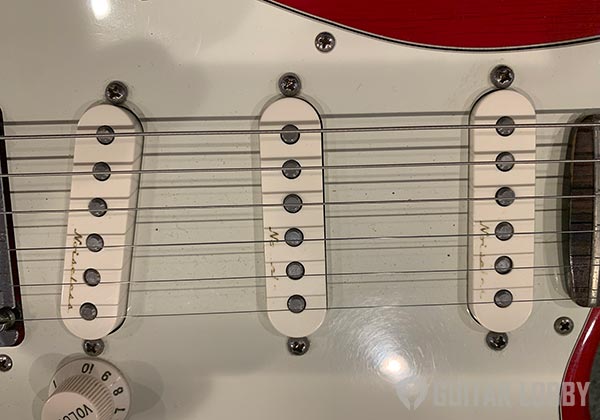
Simply put, an electric guitar without pickups is not an electric guitar! They convert the vibrations from the strings into an electric signal that flows down the cord right into an amplifier.
A pickup has poles, magnets with copper wire wrapped around them. It amplifies the sound of an electric, but the output you get depends a lot on their position. If located closer to the neck, the sound will be thicker and well-balanced. But, the one near the bridge tends to produce a sharper, “twangy” sound.
There are two kinds of pickups- single-coils and humbucker. A single-coil pickup delivers a more expressive, brighter, crisper sound but becomes noisy during overdrive. Humbuckers are a powerful arsenal for rock, blues, jazz, and metal guitarists. They have two wire coils instead of one at each end of the magnet. These pickups cancel out the “hum” noise making the sound smooth and rounded.
In most semi-acoustics, you’ll find something called a piezo pickup. These are installed on the bridge, specifically under the saddle of your guitar, where strings are tight. This way, every note comes out clear, well-defined, and authentic.
Pickup Selector Switch
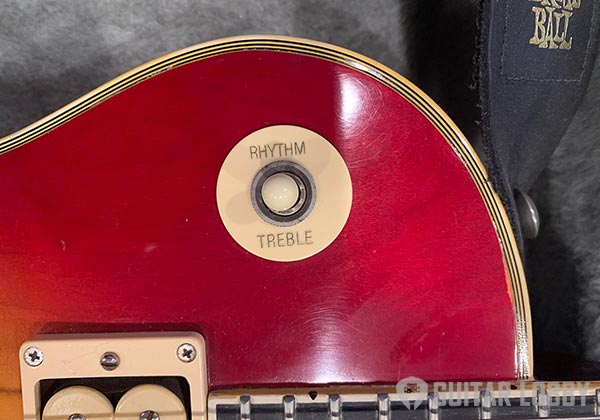
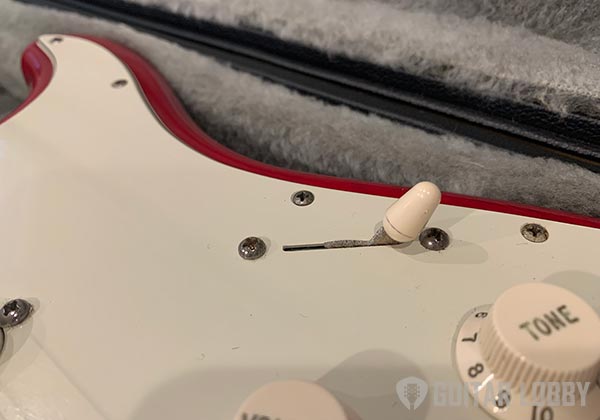
Found in guitars with more than one pickup, pickup selector switches allow players to toggle between pickups. 3-way selector switches are located on standard Gibson Les Paul, which either only activates neck pickup, bridge pickup, or a blend of both. Standard Fender Strats, on the other hand, have three single-coil pickups and a 5-way switch to toggle between them.
Volume and Tone Controls
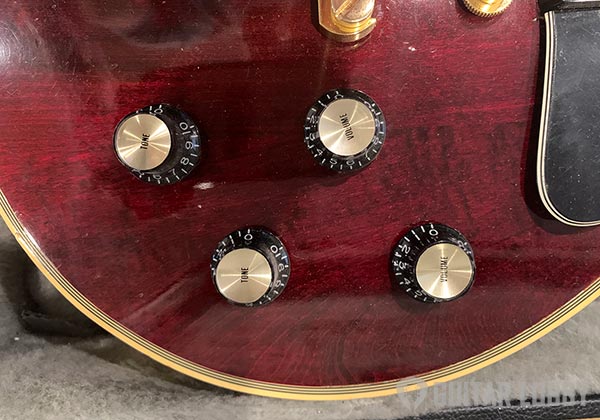
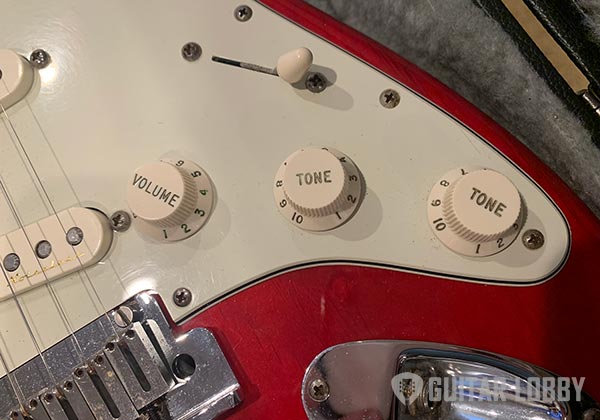
Pretty much what the name suggests – they control the volume and tone of your electric guitar. They are found close to the pickup and are used to tailor the sound by adjusting the loudness as well as bass and treble frequencies.
While most guitars with 3-way selectors have only one volume and tone knob each, Gibson Les Paul comes with 2 volume and two tone control knobs to alter the sound of the pickups individually or simultaneously. Most Strat-style guitars, however, have only one volume knob, so the loudness gets regulated together for all pickups. Thankfully, there’s a separate tone knob for each pickup.
Final Thoughts
Just like a warrior must know all about his sword, a guitarist should know everything about their electric guitar. We also have an in-depth guide on the parts of an acoustic guitar if you’re interested.
Whether you’re a beginner or a veteran that shreds without breaking into a sweat, knowing about all the parts of an electric guitar will help you a great deal. Not only will it give you a deeper appreciation of all that goes into producing that awesome guitar tone, but it will also help you maintain your instrument well and keep it in tip-top, gig-ready shape.
I hope that this article gave you a deeper insight into just how amazing your electric guitar is! Several components – both small and big – all come together to help you express yourself musically as freely as you want. This article also goes to show that this instrument is a finely tuned machine that must be kept in good shape so that you can enjoy playing it for years. To do this, it’s a great idea to routinely check the health of your guitar – from its strings, its intonation, hardware, electronics, and the output jack.
Early and prompt repair of any damaged part will preserve the sound and quality of your instrument. If you live in a very humid or cold area, I recommend keeping your electric guitar in a good quality guitar case at all times to avoid warping or rusting of the strings. Happy playing, and we hope you keep creating awesome music with your guitar!

My name is Chris and I’ve had a passion for music and guitars for as long as I can remember. I started this website with some of my friends who are musicians, music teachers, gear heads, and music enthusiasts so we could provide high-quality guitar and music-related content.
I’ve been playing guitar since I was 13 years old and am an avid collector. Amps, pedals, guitars, bass, drums, microphones, studio, and recording gear, I love it all.
I was born and raised in Western Pennsylvania. My background is in Electrical Engineering, earning a Bachelor’s degree from Youngstown State University. With my engineering experience, I’ve developed as a designer of guitar amplifiers and effects. A true passion of mine, I’ve designed, built, and repaired a wide range of guitar amps and electronics. Here at the Guitar Lobby, our aim is to share our passion for Music and gear with the rest of the music community.
